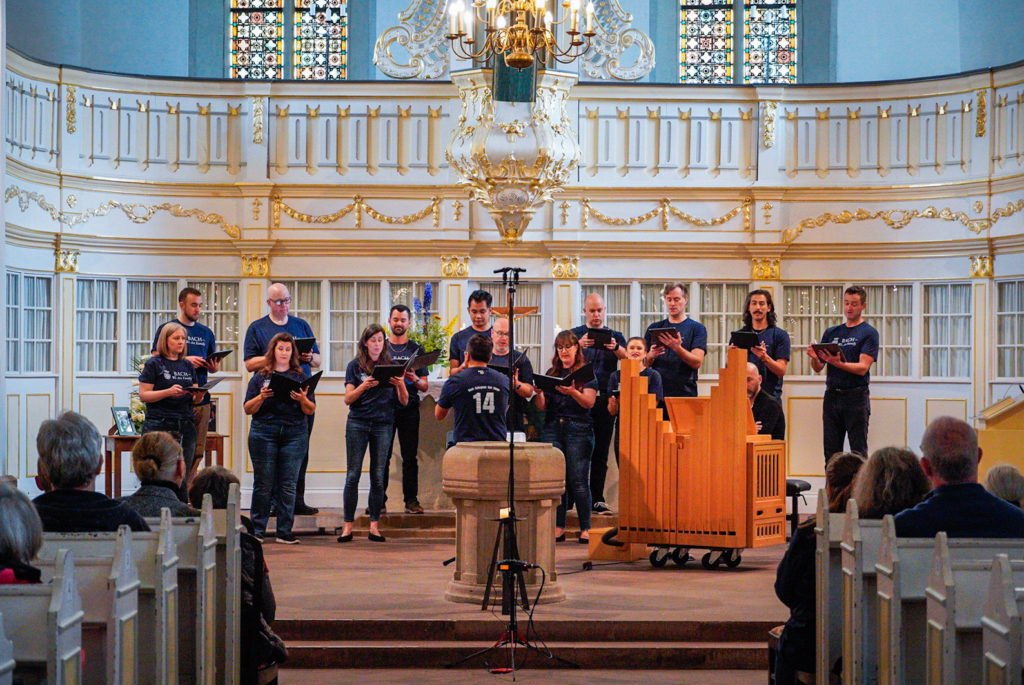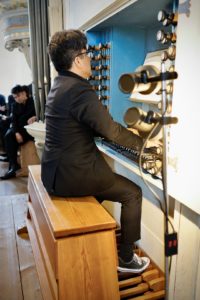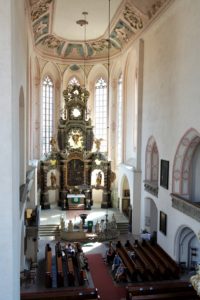The Bach Collegium San Diego Celebrates German Baroque Motets in Saxony
After the Bach Collegium San Diego’s Tuesday concert of Bach cantatas presented at Leipzig’s Paulinum, later in the week Artistic Director Ruben Valenzuela took the ensemble to the neighboring cities of Naumburg and Arnstadt to perform a second program devoted to Baroque sacred motets. Each of these cities can claim a unique J. S. Bach connection. In 1747, J. S. Bach was engaged to visit Naumburg and provide certification that the newly installed Hildebrandt organ at the St. Wenzel Church had fulfilled every aspect of its contract. Bach gave this splendid instrument his full approval, and after careful restoration in the latter years of the last century, this instrument has been returned to its early splendor.
Arnstadt, however, can boast a deeper Bach connection. At the town’s Neue Kirche, Bach held his career’s first musical position as its organist from 1703 to 1707. And in 1935, as the 20th-century Bach Revival was in full swing, the town changed the name of this church to the Johann Sebastian Bach Kirche.At each concert in these historic churches, the Bach Collegium opened with J. S. Bach’s Ich lasse dich nicht, BWV Anh. 159, a recently discovered motet for double choir. Unlike the intricately contrapuntal motets of the High Renaissance, this Bach motet bristles with short, highly declamatory chordal phrases, often used in vivid alternation. These dramatic possibilities Valenzuela stressed to great effect, especially in the wonderfully reverberant acoustics of the Naumburg Church. At St. Wenzel, the Bach Collegium sang from the high third balcony in which the organ is placed, whereas in Arnstadt, the ensemble sang from the edge of the chancel, which gave a more intimate, chamber music feeling to the motets.
Another motet for double choir, Herr, nun lässest du deinen Diener, by J. S. Bach son Johann Christian Bach, also featured lively, rhythmic phrases that brought unusual intensity to this text known in the Latin liturgy as the Nunc dimittis, or the Biblical canticle of Simeon. Valenzuela showed some of the roots of J. S. Bach’s musical style by featuring two motets by his early 17th-century predecessor as Cantor (Music Director) at Leipzig’s St. Thomas Church, Johann Hermann Schein. His Da Jakob vollendet hatte is a setting of the final benediction given by the Jewish patriarch Jacob to his sons, a moving, exceptionally chromatic excursion into early Baroque monody that creates a mystical glow in any setting, but most especially in high, vaulted nave of St. Wenzel. The Bach Collegium also brought a rich, warm sonority to Schein’s exultant motet Ich freue mich im Herren.At Naumburg’s St. Wenzel Church, Valenzuela added an aptly grand J. S. Bach organ solo to the mid-day choral concert, the Fantasia in G Major,
BWV 572, also known by the title Pièce d’orgue. The opening section’s charming, unusually extended arpeggiated filigree gives no hint of the massive chordal chaconne that follows and steadily builds to a blazing coda. Although Valenzuela was given no time to prepare his registrations–the modest rehearsal time available upon arrival at the church was solely devoted to preparing the singers–he gave a masterful account of this cherished Bach work, while providing a rewarding display of the rich, brilliant sonority of the historic instrument, especially the robust reeds in the pedal division. Most of the choral repertory required support from organ continuo, which Associate Music Director Michael Sponseller supplied–on the Hildebrandt in Naumburg and on a positiv instrument (pictured above) in Arnstadt–with his customary acumen and keyboard finesse.Before J. S. Bach received his first musical position, generations of Bach family members had flourished in the music profession in that region of today’s Germany known as Saxony. This Bach Collegium program featured the motet Fürchtet euch nicht by J. S. Bach’s father-in-law Johann Michael Bach, a spirited setting of the angelic message found in the Lucan Nativity narrative. Valenzuela’s aptly driving tempo and the singers’ clear articulation made a winning case for this little known composer. And this motet closes with a straight-forward setting of the chorale “Gelobet seist du, Jesu Christ,” the same chorale that serves as the basis of J. S. Bach’s cantata Gelobet seist du, Jesu Christ, BWV 91, that the Bach Collegium had performed on Tuesday at Leipzig’s Paulinum.
The singers’ final J. S. Bach offering, his motet Der Geist hilft unser Schwachheit auf, BWV 226, (also known by its English title The Spirit also Helpeth Us) brought these concerts to an inspiring conclusion. A tour de force of contrapuntal writing, this motet is written for double chorus and sports a daunting double fugue at its center. The 14 singers of the Bach Collegium San Diego conjured an exuberant harmony that evoked Scripture’s heavenly host.
These two concerts were presented by the Bach Collegium San Diego: on June 12, 2024, at the Church of St. Wenzel, Naumburg, Germany, and on June 14, 2024, at the J. S. Bach Church in Arnstadt, Germany.

Ken Herman, a classically trained pianist and organist, has covered music for the San Diego Union, the Los Angeles Times’ San Diego Edition, and for sandiego.com. He has won numerous awards, including first place for Live Performance and Opera Reviews in the 2017, the 2018, and the 2019 Excellence in Journalism Awards competition held by the San Diego Press Club. A Chicago native, he came to San Diego to pursue a graduate degree and stayed.Read more…




What brought us to our spiritual knees and real tears to our eyes was the closing piece by JC Bach,
Es ist nun aus mit meinem Leben, by now a most welcome Ohrwűrm; my sister and I have been humming it for two days…
The entire concert, both of them and their venues, were profound.